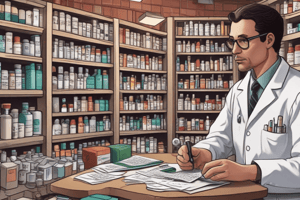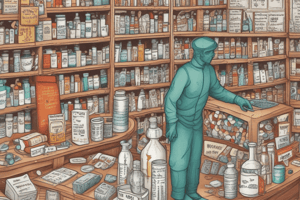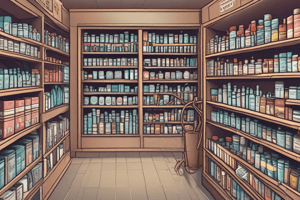Podcast
Questions and Answers
What is the main reason for the government control of certain substances?
What is the main reason for the government control of certain substances?
- Because they may be abused or cause addiction (correct)
- Because they are expensive
- Because they are only available by prescription
- Because they are only used in hospitals
What is the responsibility of the Division of controlled drugs, DRAP?
What is the responsibility of the Division of controlled drugs, DRAP?
- To manufacture controlled substances
- To dispense controlled substances to patients
- To regulate and allocate quota of narcotic drugs (correct)
- To prescribe controlled substances to patients
How many categories of controlled substances are there?
How many categories of controlled substances are there?
- Five
- Four
- Three (correct)
- Two
What are controlled substances with known medical use available by?
What are controlled substances with known medical use available by?
Which of the following is NOT a category of controlled substances?
Which of the following is NOT a category of controlled substances?
What is the name of the law that regulates controlled substances used as medicines?
What is the name of the law that regulates controlled substances used as medicines?
What is the purpose of the UN Conventions?
What is the purpose of the UN Conventions?
What is the primary function of the Ministry of Narcotics Control?
What is the primary function of the Ministry of Narcotics Control?
What is the name of the agency responsible for regulating and allocating the quota of controlled substances?
What is the name of the agency responsible for regulating and allocating the quota of controlled substances?
What is the primary focus of the Controlled Substances management system?
What is the primary focus of the Controlled Substances management system?
What is the preferred method of manual documentation for controlled substances?
What is the preferred method of manual documentation for controlled substances?
What is the purpose of having a clear chain of signatures in controlled substance records?
What is the purpose of having a clear chain of signatures in controlled substance records?
What is a key principle of successful inventory management?
What is a key principle of successful inventory management?
Why is it important to keep quantities of controlled substances to a minimum?
Why is it important to keep quantities of controlled substances to a minimum?
What should be considered when determining the drug needs of a healthcare facility or patient care area?
What should be considered when determining the drug needs of a healthcare facility or patient care area?
Who should handle, prescribe, or have access to controlled substances?
Who should handle, prescribe, or have access to controlled substances?
Where should controlled substances be stored?
Where should controlled substances be stored?
Why should inventory levels be periodically reviewed?
Why should inventory levels be periodically reviewed?
What is a goal of inventory management?
What is a goal of inventory management?
What is the purpose of accounting for all keys at all times?
What is the purpose of accounting for all keys at all times?
Who should supply a hospital with a controlled substance?
Who should supply a hospital with a controlled substance?
What is the purpose of setting up systems to uniquely identify each user?
What is the purpose of setting up systems to uniquely identify each user?
What is the benefit of accurate and complete records of controlled substance transactions?
What is the benefit of accurate and complete records of controlled substance transactions?
What should be minimized in the procurement process?
What should be minimized in the procurement process?
Why is it important to maintain secure storage?
Why is it important to maintain secure storage?
What should be assessed during inventory reviews?
What should be assessed during inventory reviews?
Why is it important to consider travel time between receiving department, pharmacy, care units, and other sites?
Why is it important to consider travel time between receiving department, pharmacy, care units, and other sites?
When using a manual procurement process, what should be done with the forms used to purchase controlled substances?
When using a manual procurement process, what should be done with the forms used to purchase controlled substances?
What should be ensured when storing controlled substances in the pharmacy department?
What should be ensured when storing controlled substances in the pharmacy department?
Who should have access to controlled substances or the areas where they are stored?
Who should have access to controlled substances or the areas where they are stored?
Why is a two-key system desirable in patient care areas?
Why is a two-key system desirable in patient care areas?
What should be done with controlled substances in locked drawers in medication carts?
What should be done with controlled substances in locked drawers in medication carts?
What is required for each formulation and container type of controlled substances?
What is required for each formulation and container type of controlled substances?
What happens when a controlled substance is manipulated or repackaged?
What happens when a controlled substance is manipulated or repackaged?
What should be used to order controlled substances in an electronic procurement process?
What should be used to order controlled substances in an electronic procurement process?
Why should blank purchase orders or requisitions for controlled substances not be pre-signed or left unsecured?
Why should blank purchase orders or requisitions for controlled substances not be pre-signed or left unsecured?
What information should be included in the pharmacy record for each medication movement?
What information should be included in the pharmacy record for each medication movement?
Who is responsible for the proper safeguarding and handling of controlled substances in the hospital?
Who is responsible for the proper safeguarding and handling of controlled substances in the hospital?
What should accompany each request for a new supply of controlled substances?
What should accompany each request for a new supply of controlled substances?
Who can write a prescription for a controlled drug?
Who can write a prescription for a controlled drug?
What should happen to a prescription for a controlled drug after it has been fulfilled?
What should happen to a prescription for a controlled drug after it has been fulfilled?
What should be done during every shift change regarding controlled substances?
What should be done during every shift change regarding controlled substances?
What should be done if a discrepancy is found in the controlled substances during a shift change?
What should be done if a discrepancy is found in the controlled substances during a shift change?
What is required for personnel involved in research using controlled substances?
What is required for personnel involved in research using controlled substances?
What records must be kept by personnel involved in research using controlled substances?
What records must be kept by personnel involved in research using controlled substances?
Flashcards are hidden until you start studying
Study Notes
Controlled Substances
- A drug or substance tightly controlled by the government due to its potential for abuse or addiction.
- Control applies to its manufacture, use, handling, storage, and distribution.
- Examples include opioids, stimulants, depressants, hallucinogens, and anabolic steroids.
Regulation of Controlled Substances
- Laws: DRAP Act, 2012, Drugs Act, 1976, and Control of Narcotic Substances (CNS) Act, 1997.
- Division of controlled drugs: DRAP in consultation with the Ministry of Narcotics Control is responsible for regulation and allocation of quota of narcotic drugs, psychotropic substances, and precursor chemicals.
Categories of Controlled Substances
- Narcotic Drugs
- Psychotropic Substances
- Precursor Chemicals
Distribution of Controlled Substances
- Fundamentals:
- Securely stored and handled throughout the medication management system.
- Accurate and complete records of all transactions maintained in a timely manner.
- All manual documentation is made in indelible ink.
- Clear chain of signatures showing transfer of responsibility at each transition point.
- Records can be easily audited.
- Principles:
- Quantities kept to the minimum needed according to patient population and degree of urgency.
- Authorized staff handle, prescribe, or have access to controlled substances.
- Stored in restricted areas, such as locked rooms, carts, or fridges.
- All keys are accounted for at all times.
- Systems set up to ensure each user is uniquely identified and every transaction can be traced.
Inventory Management
- Key principles:
- Keeping stock secure at all times.
- Maintaining accountability and sign-offs by authorized staff at all transition points.
- Checking for completeness of an order and integrity of the product at all transition points.
- Consideration should be given to maintaining the lowest amount of inventory possible while ensuring reasonable and timely access.
- Factors to consider when determining drug needs:
- Medical conditions being treated.
- Local protocols, pathways, and care maps.
- Drug formulary and formulary policies.
- Utilization and prescribing patterns.
- Range of dosing (e.g., pediatric vs adult care; acute vs chronic pain management).
- Availability and capacity of secure storage.
- Travel time between receiving department, pharmacy, care units, and other sites.
Procurement
- Licensed dealer (e.g., manufacturer or distributor) shall supply a hospital with a controlled substance.
- Manual Procurement Process:
- Manual ordering should be minimized.
- Forms used to purchase controlled substances should be sequentially prenumbered and closely controlled using a log.
- Under no circumstances should blank purchase orders or requisitions for controlled substances be pre-signed or left unsecured.
- Electronic Procurement Process:
- Only restricted to individual authorized users.
- Should have unique access code to order controlled substances.
Storage
- Controlled substances maintained in the pharmacy department should be stored:
- In a manner that ensures their physical security.
- Adhering to the recommended storage conditions for the drug.
- Meeting relevant standards (e.g., from accreditation or regulatory authorities).
- Access to controlled substances or areas where they are stored should be further limited to designated pharmacy staff.
Storage in Patient Care Areas
- Should use a double or triple lock procedure.
- The medication room door and the locked cupboard should never have the same lock.
- Alternatively, controlled substances may be stored in locked drawers in medication carts used to deliver the drugs to patients but it should never be left unattended.
Dispensing
- Each formulation and container type should have a separate record within the perpetual inventory.
- For each medication movement, the pharmacy record should include:
- Date.
- Time of issue.
- Patient care area.
- Drug name, strength, and dosage form.
- Quantity delivered or returned.
- Names and signatures of pharmacy and patient care area staff involved.
Model Set of Hospital Control Procedures
- Responsibility for controlled drug substances in hospital:
- Administrator is responsible for the proper safeguarding and handling of controlled substances.
- Pharmacist in chief is responsible for purchase, storage, accountability, and proper dispensing of controlled substances.
- Registers must be maintained for dispensing of controlled substances.
- Ward stock for controlled substances:
- Stock is replaced by duly signed sheet and provision of empty vials.
- Each request for new supply is accompanied by a controlled drug administration form.
- For any drug that is lost or wasted, the nurse in charge must prepare an incident form.
Doctor's Order for Administration of Controlled Drug
- Duly signed by physician in non-edible ink.
- Prescription can only be written by licensed and authorized physician or registered resident.
Miscellaneous Regulations
- Ward supplies of controlled medicines should only be used for patients on the ward.
- Narcotic prescriptions are not refilled.
- Prescription is retained for records.
- Physician may not prescribe narcotics for personal use.
Control of Narcotics by Nurses
- Narcotics are audited for count and use in every shift change.
- Every shift has a designated nurse for narcotics control.
- Both the nursing staff from new and old shift sign the records.
- If discrepancy found, it should be reported to the pharmacy.
Research Use
- Personnel involved in research are to be registered under DRAP rules.
- If there are more than one location, each location has to be registered separately.
- Each personnel has to keep records of research and controlled substance used, including:
- Receipt records.
- Dispensing records.
- Administration records.
Studying That Suits You
Use AI to generate personalized quizzes and flashcards to suit your learning preferences.




